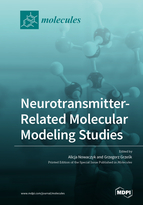Neurotransmitter-Related Molecular Modeling Studies
A special issue of Molecules (ISSN 1420-3049). This special issue belongs to the section "Molecular Structure".
Deadline for manuscript submissions: closed (15 November 2021) | Viewed by 52551
Special Issue Editors
Interests: organic and medicinal chemistry; computational chemistry and molecular modeling of GAT, MAT, VGIC; predictive modelling of detailed mechanisms of action and pharmacological effec-tiveness of biologically active compounds and chemical reaction pathways; neuropharmacology; cardiovascular; safety pharmacology
Special Issues, Collections and Topics in MDPI journals
Interests: clinical and experimental pharmacology; cardiovascular pharmacology; internal medicine; en-dothelial function; vascular smooth muscle function; direct oral anticoagulants; therapeutic drug monitoring; antiplatelets agents
Special Issues, Collections and Topics in MDPI journals
Special Issue Information
Dear Colleagues,
The year 2021 is the 100th anniversary of the confirmation of the neurotransmission phenomenon by Otto Lewi. For this reason, we invite you to participate in the celebration of this event by participating in a Special Issue of Molecules devoted to neurotransmission-related phenomena.
Neurotransmitters are chemicals that enable communication, i.e., the flow of nerve impulses between nerve cells, or between nerve cells and muscles and glands. Recently, one can distinguish excitatory and inhibitory mediators, which are both endo–exogenous compounds that control the function of the whole organism. From a chemical point of view, neurotransmitters belong to many different structural groups, such as amino acids (such as glycine), peptides (such as substance P, somatostatin), monoamines (such as noradrenaline or dopamine), purine derivatives (such as adenosine), gases (such as nitrogen, NO, carbon monoxide CO) or acetylcholine. From a medical point of view, disturbances in the concentration of neurotransmitters in the body result in the occurrence of mental disorders and diseases (such as depression, schizophrenia, Parkinson’s disease), contribute to the occurrence of dementia (including Alzheimer’s disease) and others. For this reason, they are used in medicine (e.g., as antidepressants), but they can also be a serious problem in non-medical use (e.g., as a psychoactive substance such as rape pills).
This Special Issue is entitled “Neurotransmitter-Related Molecular Modeling Studies” and aims to bring together research on all aspects of molecular modeling in the neurotransmission phenomenon. It will contain high-quality research articles and review articles summarizing the state-of-the-art in a specific area of this research field.
Prof. Dr. Alicja Nowaczyk
Prof. Dr. Grzegorz Grześk
Guest Editors
Manuscript Submission Information
Manuscripts should be submitted online at www.mdpi.com by registering and logging in to this website. Once you are registered, click here to go to the submission form. Manuscripts can be submitted until the deadline. All submissions that pass pre-check are peer-reviewed. Accepted papers will be published continuously in the journal (as soon as accepted) and will be listed together on the special issue website. Research articles, review articles as well as short communications are invited. For planned papers, a title and short abstract (about 100 words) can be sent to the Editorial Office for announcement on this website.
Submitted manuscripts should not have been published previously, nor be under consideration for publication elsewhere (except conference proceedings papers). All manuscripts are thoroughly refereed through a single-blind peer-review process. A guide for authors and other relevant information for submission of manuscripts is available on the Instructions for Authors page. Molecules is an international peer-reviewed open access semimonthly journal published by MDPI.
Please visit the Instructions for Authors page before submitting a manuscript. The Article Processing Charge (APC) for publication in this open access journal is 2700 CHF (Swiss Francs). Submitted papers should be well formatted and use good English. Authors may use MDPI's English editing service prior to publication or during author revisions.
Keywords
- Molecular modeling
- Structural analysis
- Neurotransmitters ligands
- Mechanism of action
- Synthesis








